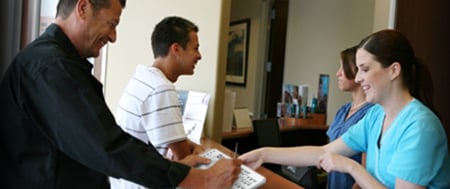Blog
Top 5 reasons why Doctor's Offices love the Confidential Patient Sign-In Book
by Paul Kazlauskas

While a patient sign-in book is used at the front desk of many doctor’s offices, it is utilized to track much more than a patient’s arrival. The form protects the doctor as well. The sign-in document proves a patient was in the office on a precise date and is necessary to avoid any claims of fraud from insurance companies. In addition, a disgruntled patient may claim they were billed for a medical procedure or medical services on a day they were not actually in the doctor’s office. The patient sign-in sheet definitely protects the doctor and office from liability, but it should also protect patient privacy.
HIPAA regulations require that patient privacy be protected, even in public waiting rooms. The Confidential Patient Sign-In Book meets HIPAA patient privacy standards. While sign-in sheets are an important part of office documentation, it is imperative not to display any patient’s name to those signing in. The Confidential Patient Sign-In Book is the perfect answer and it performs two jobs in one step. The white first part contains a "blockout" pattern on all last names to protect the confidentiality of those signing in. The yellow second part provides an automatic duplicate record that lets only the office personnel see the names that are "blocked out" on the white first part.
Here are the Top 5 reasons why Doctor’s Offices love the Confidential Patient Sign-In Book…
1. Confidentiality. Visitors write their last name on the “blockout” pattern, making that information unreadable to ensure patient privacy. You can call patients by their first name (readable on top sheet) when it is their turn to see the doctor.
2. Duplicate Log. The 2nd sheet keeps a readable record, so you’ll know now, and months later, when a patient was in your office and which doctor they had an appointment with. There is no “blockout” pattern on the duplicate log.
3. Sealed Right Edge. The right edges of the original sheet and duplicate sheet are sealed together to prevent snooping.
4. Customization. Your office name and logo makes this form your own. Proudly promote your office’s identity to all those that sign in.
5. Portability. The sign-in sheets are wirebound into a portable book in case of an emergency evacuation.
Want the latest, best security practices delivered straight to your inbox? Enter your email address in the "Subscribe" area (on the left side navigation).
Download Free Whitepaper ›
Our exclusive "Guide to Choosing a Visitor Management System"
Follow us on Social Media for more security content.![]()
![]()
![]()
Posted on 2/5/2015



 Paul Kazlauskas
Paul Kazlauskas
 Andrew Jones
Andrew Jones